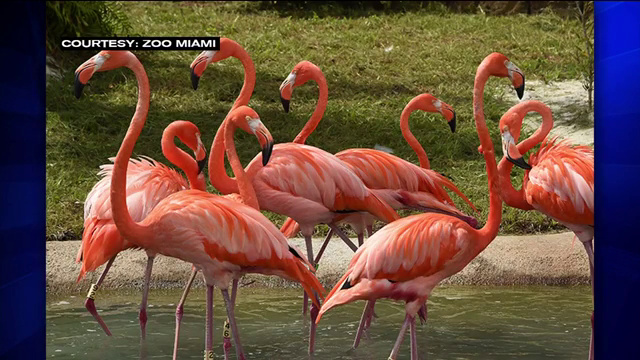MIAMI (AP) — The American Flamingo has been such an iconic image that has been used to represent Florida for so long — from the Greetings From Florida postcards of the last century to the opening credits of “Miami Vice” in the mid-1980s — one might be excused for thinking the birds are classified as native species and protected.
But that isn’t the case of the only flamingo species native to the United States.
American Flamingos have never been considered as a focal species for conservation, management or monitoring in Florida, according to a group of researchers, including from Zoo Miami, Cape Florida Banding Station and Big Cypress National Preserve. Zoo Miami’s Steven Whitfield led the research.
So Zoo Miami has partnered with the Tropical Audubon Society, the Cape Florida Banding Station, the Florida Keys Audubon Society, Brevard Zoo and other organizations and scientists to help protect the bright pink birds.
The South Florida researchers submitted a petition to the Florida Fish and Wildlife Conservation Commission to consider changing the present classification of the American Flamingo as a “non-native species” to a “native species.” This designation by the FWC would make the American Flamingo considered a “species of special concern” or “threatened” and lead to their protection and help conserve the population.
According to Zoo Miami spokesman Ron Magill, the researchers cited more than 60 published reports and gathered scientific data to indicate that the American Flamingo “did indeed historically nest and reproduce in Florida.”
In February, a comprehensive study published in the American Ornithological Society’s journal The Condor finally provided an answer to a century-old debate: Flamingos are likely natives, though their footprint in Florida is as light as their hot pink feathers. The study was written by Antonio Pernas, a botanist for the Big Cypress National Preserve, with Zoo Miami’s Whitfield and Frank Ridgely, Audubon Florida’s Pete Frezza and Jerry Lorenz, and biologists Anne Mauro and Judd Patterson.
Before his death in 1851, ornithologist John James Audubon observed the American Flamingo in the Florida Keys. Large flocks foraged in the Keys and Florida Bay and could have numbered in the thousands but were almost wiped out by 1900 as they were hunted for food and for their plumes.
Today, estimates suggest the number of American Flamingos has apparently at no time exceeded 500 individuals between 1903 and 2015, according to Whitfield’s research. The largest group of individuals recorded in Florida since 1902 was a flock of 147 individuals that appeared in Stormwater Treatment Area 2 in Palm Beach County in the spring of 2014.
The greatest number of individual flamingos in Florida Bay was a flock of 65 observed in January 1998. “Many habitats used by flamingos are remote,” Whitfield’s research noted.
Across the Caribbean, the total number of individuals has been estimated between 260,000 and 330,000, with the largest nesting colonies in Cuba and Grand Inagua in the Bahamas, according to the IUCN Red List of Threatened Species. The largest nesting area in Cuba, at Humedal Rio Maximo Camagⁿey, had between 22,000 and 51,600 nesting pairs from 1998 to 2008, but Hurricane Ike in September 2008 devastated the nesting site and destroyed its research center.
One of the most famous South Florida images of the American Flamingo was taken by Magill during another hurricane 26 years ago. As Hurricane Andrew, a Category 5 storm, barreled toward South Miami-Dade, zookeepers at then-named Miami Metrozoo (now Zoo Miami) herded 54 of the attraction’s flamingos into its bathrooms and kept them safe.
Aside from its cameo two-seconds into the “Miami Vice” credits for five seasons, which featured the flamingos at Hialeah Park’s race track, the flamingo has been a cultural staple, serving as the visual mascot for pop singer Christopher Cross on all of his albums since his Grammy-winning debut in 1979.
There’s the Flamingo Hotel and Casino Las Vegas, the Flamingo Visitors Center in Homestead, Flamingo Park in South Beach, and the bird’s name and shocking pink coloring is adorned on countless buildings across the country.
“As a cultural icon of Florida and an important component of Florida’s natural heritage, we expect there is broad public support for conservation of American Flamingos,” Whitfield and his team of researchers said in its petition to the FWC.
“Protection of American Flamingos under Florida’s threatened species laws and inclusion of American Flamingos in monitoring or management plans for native species would lay a strong initial foundation for the conservation of one of Florida’s most iconic birds.”
Copyright 2024 The Associated Press. All rights reserved. This material may not be published, broadcast, rewritten or redistributed.

